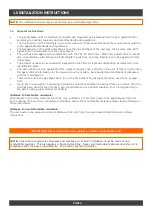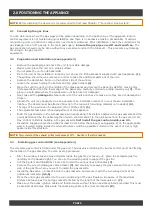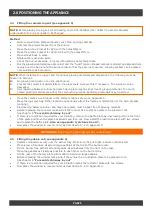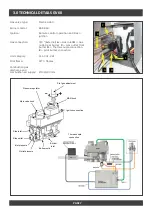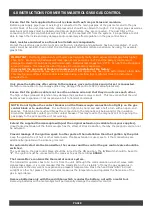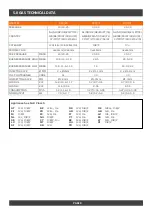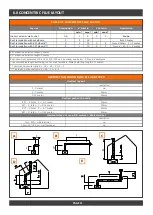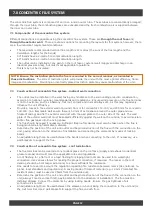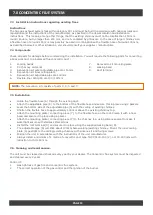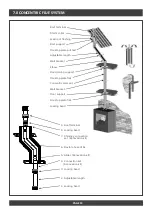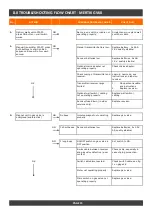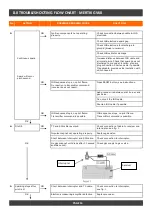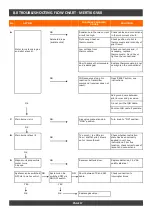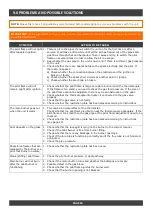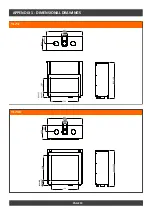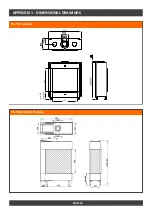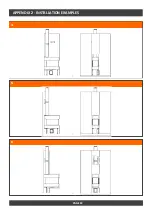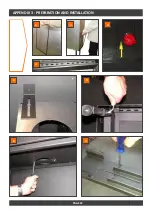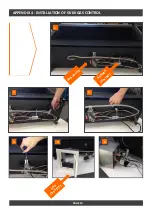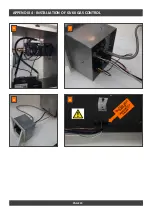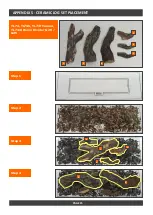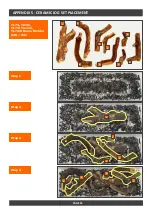
9.0 PROBLEMS AND POSSIBLE SOLUTIONS
IMPORTANT:
Solving problems with your unit, whether gas related or electrical, must always be performed by
a qualified technician.
NOTE:
Please first check if all guidelines were followed before attempting to solve any problems with the unit.
PAGE 18
SYMPTOM
ACTION TO BE TAKEN
The pilot flame will not light
after repeated ignition.
1. There is air in the pipes if you switch the unit on for the first time or after a
service.
It will take a little while until all the air has flowed out of the pipes and
gas flows through that can be ignited.
Take it away and try to switch the pilot
flame on several times in order to allow the air to escape.
2. See whether the gas pipe to the unit is open and if there is sufficient gas pressure
to the unit.
3. Check whether there are sparks between the spark electrode and the pilot.
If
there are no sparks:
a) Check whether the connection between the electrode and the ignition is
broken or faulty.
b) Check whether the spark short circuits at another point or jumps.
c) Check whether the electrode is broken.
The pilot flame will not
remain alight after ignition.
1. Check whether the pilot flame is large enough to burn around the thermocouple.
If the flame is too small, you need to check the gas feed pressure.
If the size of
the pilot flame cannot be adjusted, there may be an obstruction in the pilot.
2. Check whether the thermocouple interrupter is connected to the gas valve
properly.
3. Check that the gas valve is not faulty.
4. Check whether the restriction plate has been placed according to instructions
The main burner goes out
when the unit is warm.
1. This can be a normal effect of the thermostat.
Check whether the pilot flame is able to heat the thermocouple adequately.
If the
pilot flame is too small then the gas pipe or the pilot flame adjustment need to be
checked.
2. Check whether the restriction plate has been placed according to instructions
(see page
25).
Soot deposits on the glass. 1. Check whether the lava split is lying on the burner in the correct manner.
2. Check if the pilot burner is free from burner filling.
3. Check whether there is any blockage in the burner openings.
4. Check if the flue tube is functioning correctly and if the flue tube is not hindered
or blocked.
5. Check the pipe pressure.
Sharp blue flames that are
released by the burner or a
pilot that burns too wildly.
1. Check whether the restriction plate has been used.
Weak (stifling) pilot flame. 1. Check the pilot burner pressure or duct pathway.
Main burner will not burn
after the pilot burner is
functioning.
1. Check if the motor button turns and whether the batteries are empty.
2. Possible defect in the gas block.
3. Check whether the pilot flame ignites the burner well.
4. Check that the burner opening is not blocked.
Summary of Contents for TL73
Page 1: ...INSTALLATION INSTRUCTIONS FOR MODELS TL73 TL73H TL73T TL73RD ...
Page 20: ...APPENDIX 2 INSTALLATION EXAMPLES PAGE 21 1 2 3 4 MAX 1500 ...
Page 21: ...APPENDIX 2 INSTALLATION EXAMPLES PAGE 22 4 5 6 ...
Page 22: ...APPENDIX 3 PREPARATION AND INSTALLATION PAGE 22 1 1 2 3 4 5 6 7 ...
Page 27: ...APPENDIX 6 ARRANGEMENT OF VARIOUS BURNER FILLINGS PAGE 29 PEBBLES 1 2 ...

